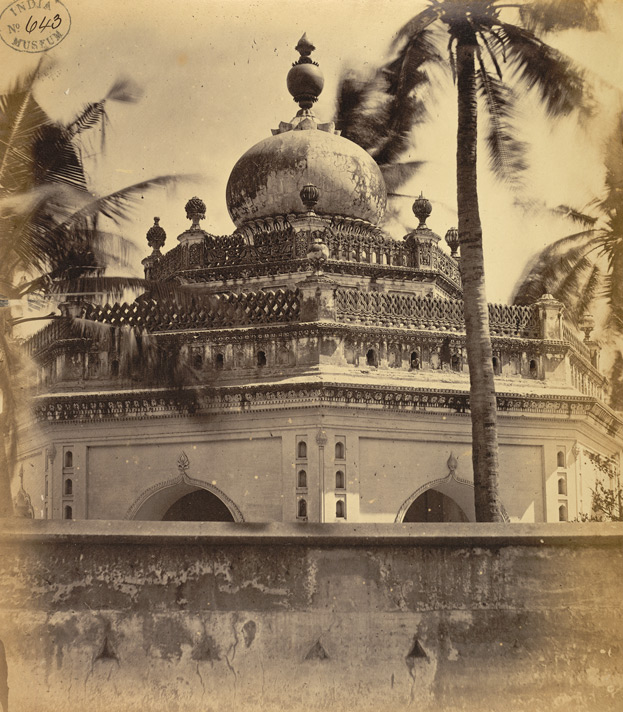 |
| Tomb of Tipu's wife Padshah begum .bl.uk/onlinegaller |
Above image: One the tombs of Tipu Sultan's family at Vellore in Tamil Nadu. It is not yet identified. Photo was taken by the Madras School of Industrial Arts around 1868; from the Archaeological Survey of India Collections. Vellore Fort, a 16th century fort that lies in the center of the city was built Vijayanagara rulers. Surrounded by moat all around, it is one of the finest forts in Tamil nadu just like the formidable fort at Gingee near Villupuram. The tomb in this photo is possibly that of Tipu Sultan's wife Padshah Begum who died in 1834. It is situated in a walled enclosure to the right of the entrance. Aftab Khan's tomb is nearby. The tombs lie east of the nearby fort (about 1.4 km). Located here is a large granite pavilion that has the tomb of Mirza Raza, who married one of Tipu's daughters and at the end there is a six metres mausoleum with a high dome to Bakshi Begum, widow of Haidar Ali, who died in 1806.
 |
| Tomb of Tipu's family, Vellore. bl.uk/onlinegallery |
Above image: Tomb of an unidentified member of Tipu's family member at Vellore; From the Archaeological Survey of India Collections: India Office Series (volume 21, 'a' numbers), possibly taken by Henry Dixon in the 1860s. . About 1.2 km to the east of the fort there are the Tombs of Tipu Sultan's Family. Entering the walled enclosure on the right are the tomb of Padshah Begum, Tipu's wife, who died in 1834 and Aftab Khan's tomb. A large granite pavilion contains the tomb of Mirza Raza, who married one of Tipu's daughters and at the end there is a six metres mausoleum with a high dome to Bakshi Begum, widow of Haidar Ali, who died in 1806. The tomb in this view is not identified.
 |
| Tomb of Tipu's family, sarsonkekhet.in |
 |
| Tomb of Tipu's family, Vellore sarsonkekhet.in |
 |
| Vellore fort, Vellore,upload.wikimedia.org |
 |
| Vellore fort, Vellore, TNarsonkekhet.in |
Above image: The Vellore Fort known for its military architecture and features that will prevent easy raid on the fort, the British East India company with HQ at Madras used it as garrison. In the 1700s it was one of the strongest forts in the Carnatic region and the English diligently used the vantage location of the fort to continue their assault on Hyder Ali and his son Tipu Sultan, their arch enemies who had set the roadblock for their expansion down south. Between 1700s until the fall of Tipu Sultan in the final Anglo-Mysore war in 1799 the English used the fort to the maximum. In 1780, the fort was on siege by Hyder Ali during the Second Anglo-Mysore War, but the British garrison held out for over two years before the siege was lifted. After the fall of Seringapatam in 1799 and the death of Tipu Sultan, Tipu's family members were imprisoned in the fort for some period, however, after the early war of rebellion in the Vellore fort in 1806 (over the religious mark on the forehead in the case of Hindu and removal of beard in the case of Muslim soldiers) some of them taken to Calcutta to prevent further protests or riots. The tomb in this view is possibly that of Tipu Sultan's wife who died in 1834, situated in a walled enclosure, to the right of the entrance.
The site can be made into an important destination for tourists, but the tombs and the enclosure need urgent repairs, restoration and proper landscaping to make it an attractive place. As Tipu happens to be an historical figure, his legacy in this part has to be maintained.
https://www.bl.uk/onlinegallery/onlineex/apac/photocoll/o/019pho001000s26u02584000.html
https://www.blogger.com/blog/post/edit/8274938273148772169/1379142709272446536
https://www.bl.uk/onlinegallery/onlineex/apac/photocoll/o/019pho001000s26u02584000.html

.jfif)


.jfif)
.jfif)

.jpg)

